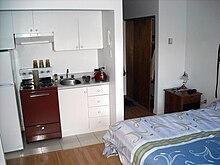Kitchenette
– Hotels and Motels:
– Kitchenettes are common in hotel and motel guest rooms
– Kitchenettes often contain a coffeemaker and a mini-bar
– Some hotel kitchenettes have provisioned refrigerators with interior sensors
– Management uses sensors to monitor guest use and charge for consumables
– Consumables typically include soda, beer, and liquor
– In Britain:
– In British English, kitchenette refers to a small secondary kitchen in a house
– Often found on the same floor as children’s bedrooms
– Used by a nanny or au pair to prepare meals for children
– Similar feature found in hotels, such as some in London
– Small Apartment Style:
– “Kitchenette” referred to a small apartment in African American communities
– Prevalent in Chicago and New York City during the mid-twentieth century
– Landlords divided single-family homes or large units into smaller units
– Living conditions in kitchenettes were often wretched
– Described as a “prison” by author Richard Wright
– Brazil:
– In Brazil, a kitchenette is a very small apartment
– Composed of one room, one bathroom, and a kitchen
– Kitchen is often in the same space as the room
– Corresponds to a studio apartment in American culture
– Similar to a bedsit in the UK and Ireland
– References:
– Department of Buildings in New York City has information on interior environments
– Archived document provides details on kitchenettes
– Jerry Washington Ward and Robert Butler wrote about kitchenettes in “The Richard Wright Encyclopedia”
– Source from ABC-CLIO in 2008
– External links to media related to kitchenettes on Wikimedia Commons
A kitchenette is a small cooking area, which usually has a refrigerator and a microwave, but may have other appliances - for example a sink. They are found in studio apartments, some motel and hotel rooms, college dormitories, office buildings, furnished basements, or bedrooms in shared houses. New York City building code defines a kitchenette as a kitchen of less than 7.4 m2 (80 ft2) of floor space.

